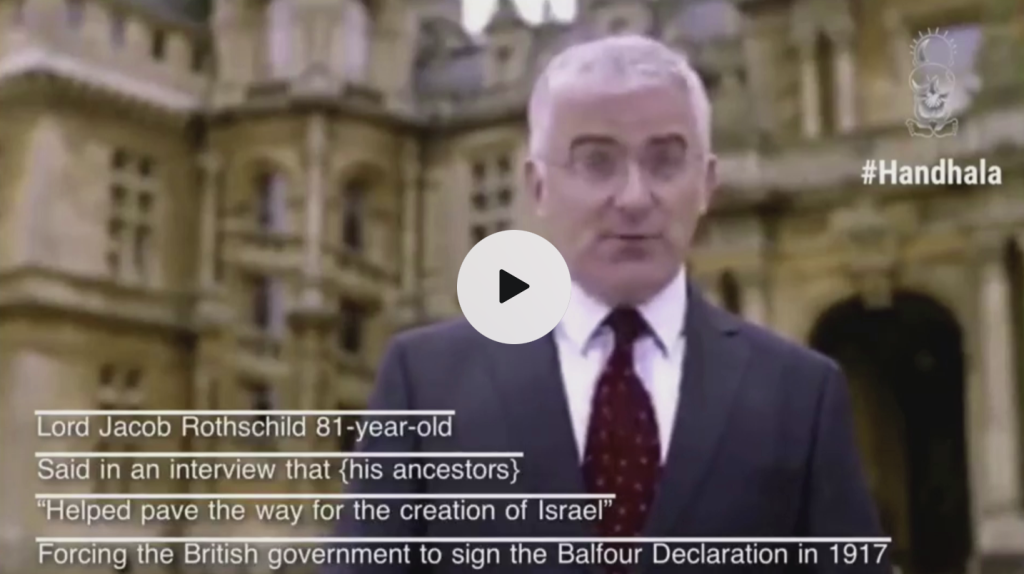Gaza and Its Astounding Parallels with 9/11: “A Territory or Country Is Targeted for Previously Established Geostrategic Goals”
Has the Israeli government betrayed its own people, as well as the Palestinians, with it’s own “9/11 Moment”?
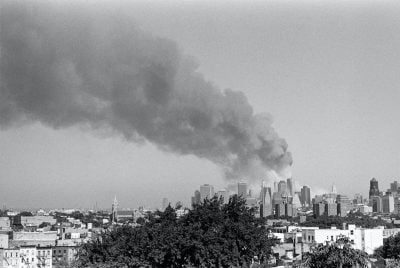
All Global Research articles can be read in 51 languages by activating the Translate Website button below the author’s name (only available in desktop version).
To receive Global Research’s Daily Newsletter (selected articles), click here.
Click the share button above to email/forward this article to your friends and colleagues. Follow us on Instagram and Twitter and subscribe to our Telegram Channel. Feel free to repost and share widely Global Research articles.
Global Research Fundraising: Stop the Pentagon’s Ides of March
***
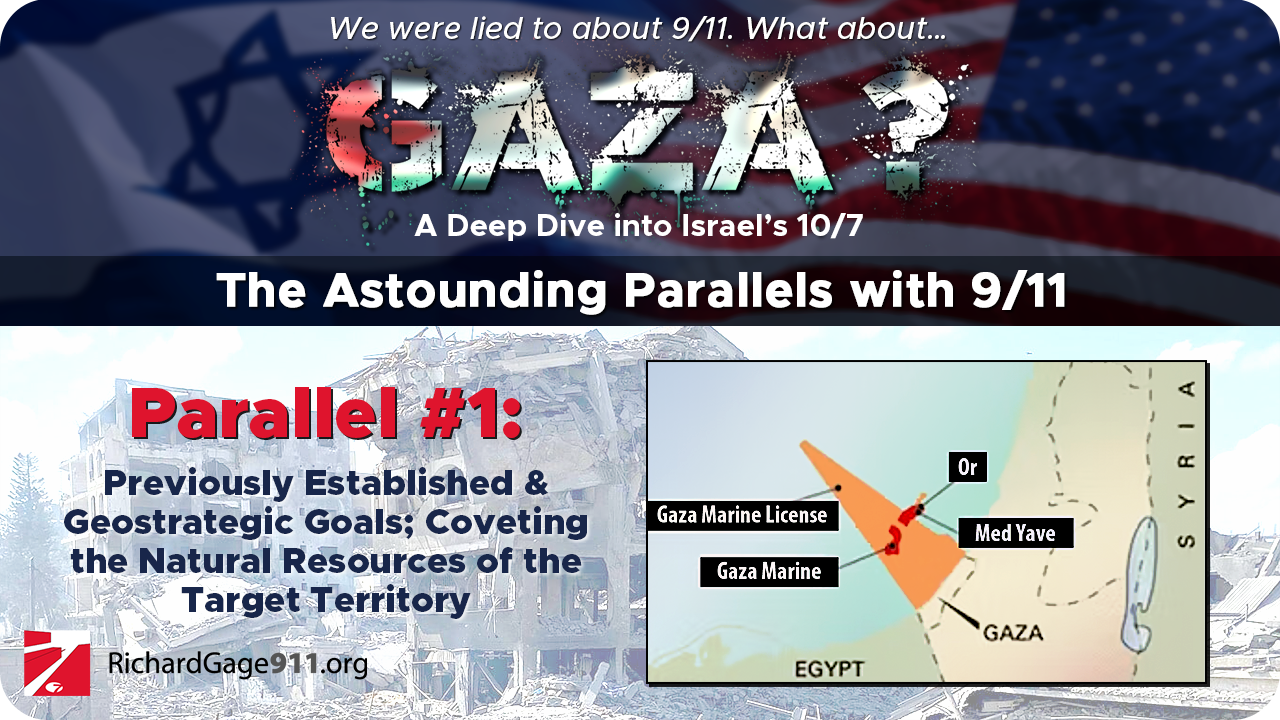
If you haven’t read the important Introduction yet, then we encourage you to read it first:
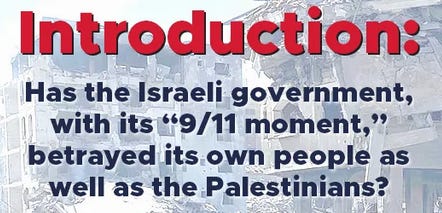
The Palestinian death toll has reached more than 30,000 with more than 70,000 wounded. About 70% of these casualties are women and children. Almost 80% of the housing infrastructure has been destroyed and so have scores of hospitals, schools, mosques, churches, cultural sites, businesses, and UN offices.
This obviously goes way beyond “self-defense.” So we must stop, and ask ourselves “Why?”
What’s really going on in Gaza, in the Middle East as a whole, and with Israel’s 9/11? And what can we learn by comparing Israel’s 9/11 to the United States’ 9/11?
Are there specific geostrategic interests in Gaza driving a depopulation agenda by Israel?
We’ll look at the natural gas fields discovered two decades ago immediately offshore of Gaza worth $453B.
We also examine the $55B Ben Gurion Canal project that Gaza is sitting in the way of. But first . . . an inquiry into the US geostrategic goals in Afghanistan and Iraq.
What are the parallels between 9/11 and Gaza? We found several.
(We all owe a huge debt of gratitude to 9/11 Researcher Kevin Ryan for his initial research on the parallels of 9/11 & Gaza which he presented at the IC911 seminar Genocide & Empire.)
A. They Create the Original PROBLEM
B. They Manage the Public REACTION
C. They Offer the Prescribed SOLUTION
We’ve found quite a number of parallels and will be diving into each of them separately in upcoming parts of this series. As you see above, they fall into one of the 3 major elements of “false flag” operations: Problem-Reaction-Solution.
Who are “they”? We will explore the complex set of answers to that question in Appendix A of this series.
Today we dive right into Parallel #1:
“A Territory or Country Is Targeted for Previously Established Geostrategic Goals.”
9/11: Project for a New American Century — NeoCon Think Tank
We start with the 9/11 side of the equation — and find, most interestingly, that the goals of the 2001 Bush Administration were established by the incoming neoconservatives and laid out in their key paper, Rebuilding America’s Defenses. These individuals founded the Project for a New American Century.
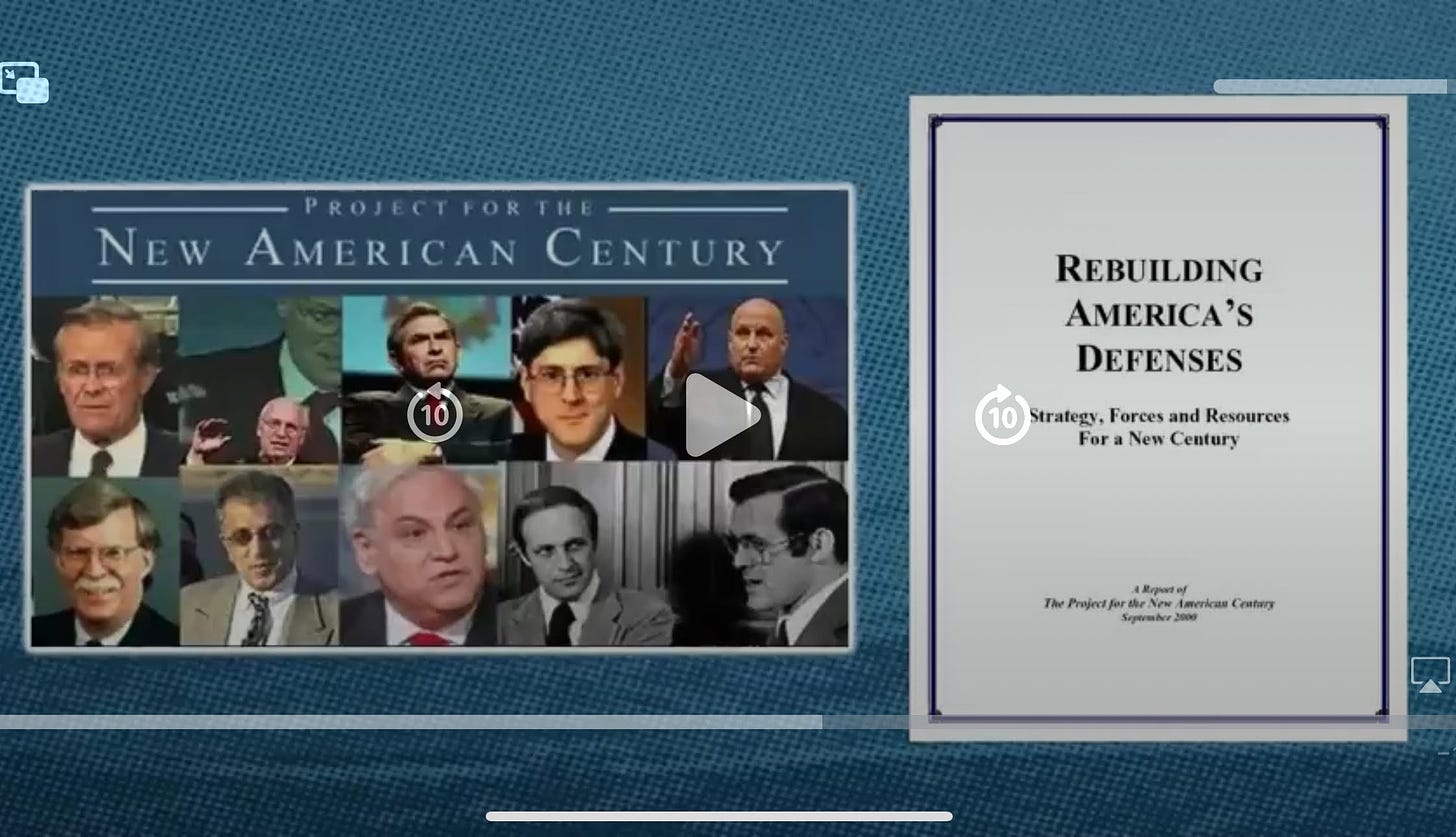
The Project for the New American Century (PNAC) was a neoconservative think tank based in Washington, D.C., that focused on United States foreign policy. It was established as a non-profit educational organization in 1997, and founded by William Kristol and Robert Kagan. PNAC’s stated goal was “to promote American global leadership.” The organization stated that “American leadership is good both for America and for the world,” and sought to build support for “a Reaganite policy of military strength and moral clarity.”
Of the twenty-five people who signed PNAC’s founding statement of principles, ten went on to serve in the administration of U.S. President George W. Bush, including Dick Cheney, Donald Rumsfeld, and Paul Wolfowitz. [Emphasis added.]
Their goals?
- A “defense topline increase of $75 billion to $100 billion . . . level of spending within four years”
- Regional hegemony in the Middle East
- To “fight and decisively win multiple, simultaneous major theater wars”
However, PNAC acknowledged in the document that:
“. . . the process of transformation, even if it brings revolutionary change, is likely to be a long one, absent some catastrophic and catalyzing event — like a new Pearl Harbor.” [Emphasis added.]
President Bush wrote as much in his diary the evening of 9/11/01, “The Pearl Harbor of the 21st Century.”
These points are among the many discussed by the late David Ray Griffin in some of his books, including New Pearl Harbor — Disturbing Questions About the Bush Administration and 9/11.
Griffin finds that the very strategic goals sought and documented by the neocons in September 2000 were substantially achieved following the earth-shaking events of September 11, 2001.
9/11: Supreme Allied NATO Commander Revealed “Take Down 7 countries in 5 years”
Bush Administration Goals Publicly
Apparently the Bush Administration had additional geostrategic goals as well. Gen. Wesley Clark, Ret. four-star US Army General, Supreme Allied Commander of NATO (during the Kosovo War), revealed these goals publicly in 2007.
He said that he had visited the Pentagon just nine days after the events of 9/11/01 and was told by another General, who had himself visited Rumsfeld and Wolfowitz, that the decision to go to war with Iraq was already made. In addition, this other general, who had previously worked for Gen. Clark, said: “We’re going to take out seven countries in five years.” [Emphasis added.]
He further clarified which countries they were: “starting of with Iraq, then Syria, Lebanon, Libya, Somalia, Sudan, and finishing off with Iran.” [Emphasis added.]
To date, the US has attacked, overthrown, and/or undermined most of these countries following the initial overthrow of Afghanistan.
The neocons who were brought in with the Bush Administration in 2000 must have come with these goals in tow. And today the US is still being pressured by the neocons to complete the unfinished dirty work on the remainder of “the list” by going to war with Israel’s arch enemies — Lebanon and Iran. Was the US support for Israel’s inordinate retaliation in Gaza, and the heavy blame that was being heaped on Iran, an effort to incite a broader regional war to take out these enemies of Israel as well?
9/11: Afghanistan — The Pre-9/11 Plan to Attack Taliban
The Bush Administration appeared to have set its sights on Afghanistan — well before September 11, 2001. After all, the Whitehouse agreed to the invasion plan on September 10 — the day before the catastrophic events of 9/11. Why?! Did they have foreknowledge of the attack? Did they have other motivations for invading the country?
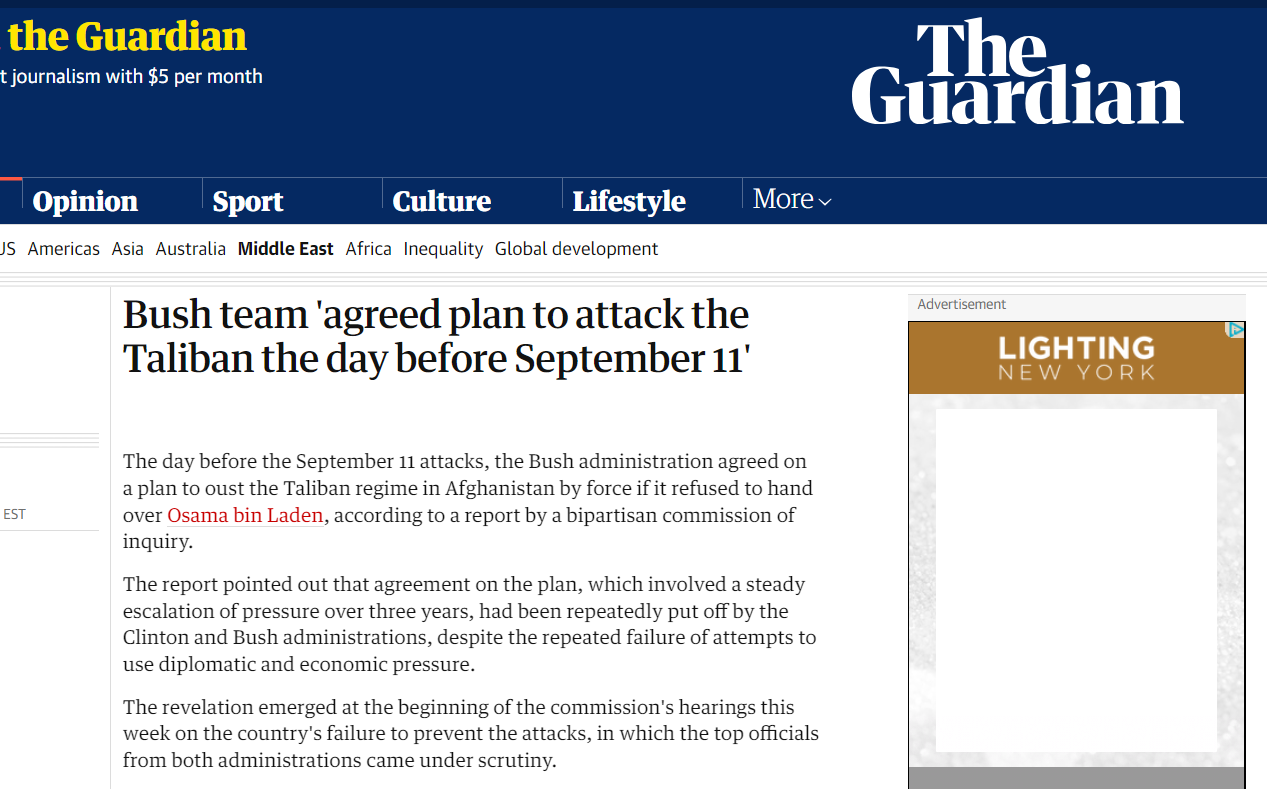
So what was the chief strategic goal of the US empire in Afghanistan under the false front of the “coalition of the willing”?
We were told it was to find Osama bin Laden. But it took the most sophisticated intelligence systems in the world more than a decade to find him. It becomes clear that he was used to run cover for a much more profitable operation. Could it have been the coveting of specific resources and geostrategic importance of the country?
Before the Taliban seized control of Afghanistan in 1996, the profits from opium poppy cultivation through the “Chain of Dope” netted $400B to $500B, which exceeded the profits from all the oil companies combined[1]. Afghanistan had exported an average of 3,300 metric tons per year according to the UN Office of Drug Control (UNODC). The Taliban then shut down the poppy cultivation in favor of food cultivation, reducing the 2001 poppy crop yield to just 185 tons — a decrease of 94%.[2]
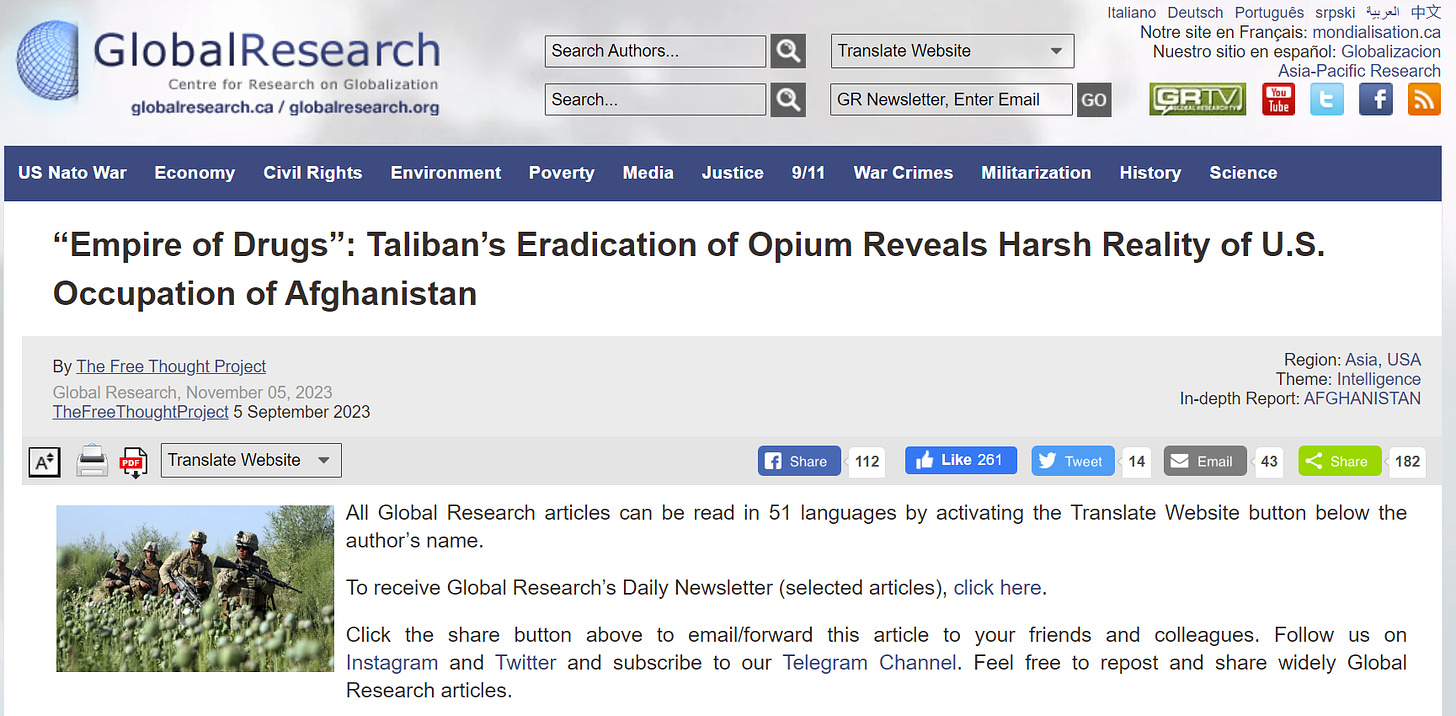
The next year, under the pretext of going after Osama bin Laden, who was purportedly the “architect” of the 9/11 attacks, the US-led invasion of Afghanistan removed the Taliban from power along with its restrictions on opium production. The yield skyrocketed back 3,400 tons in 2003 (profits exceeded $180B per year) and then rocketed to 6,100 tons in 2006.[3]
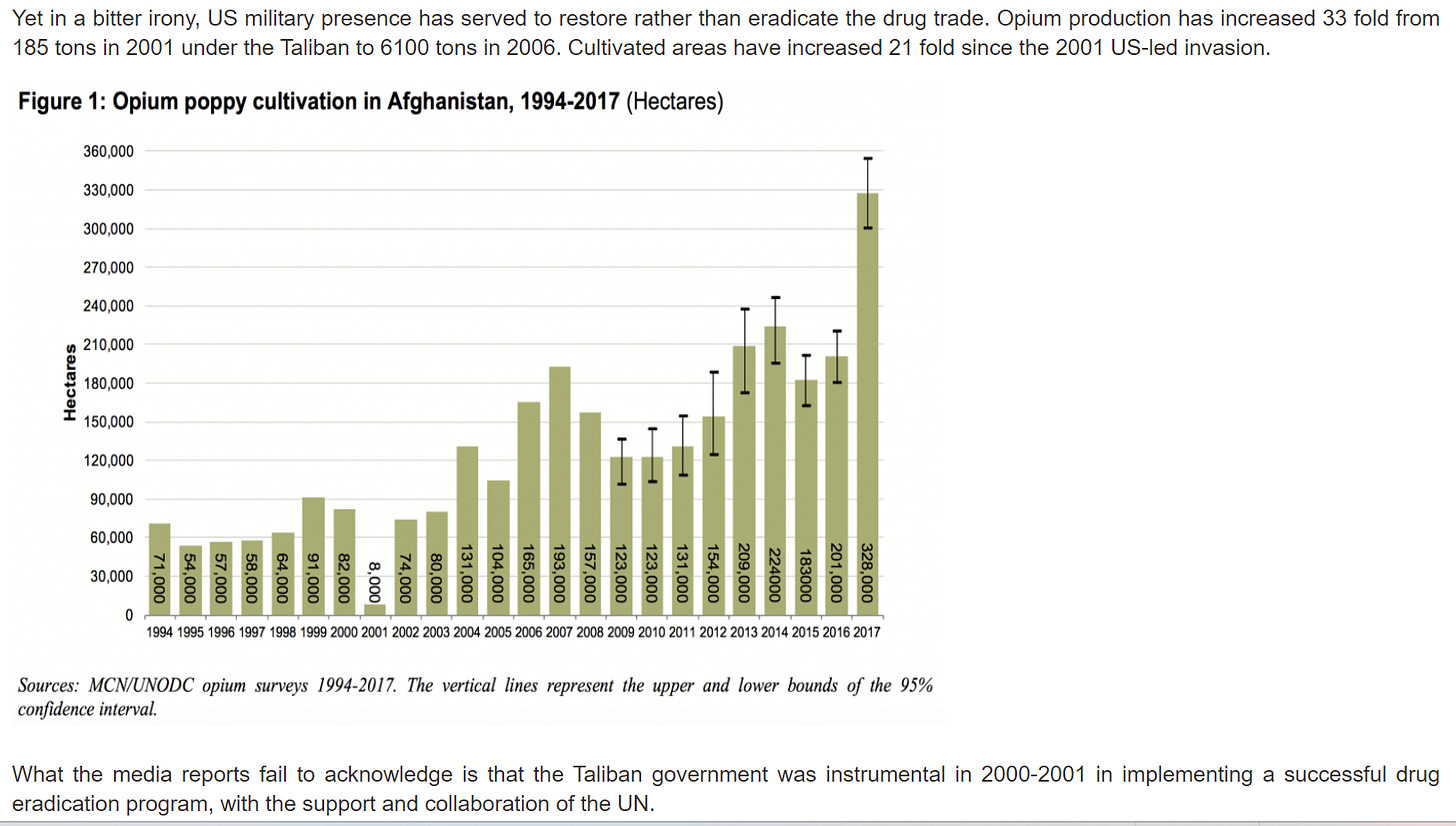
Don Paul and Jim Hoffman also document all of this quite well in their powerful little book Waking Up From Our Nightmare — The 9/11/01 Crimes in New York City. In that book they describe the “Pop” — an exponential increase in profits going to corrupt Wall Street companies and banking institutions from the narco-dollars.[4] These profits put the oil business profits to shame.

What happened when the US was forced back out of Afghanistan by the Taliban in 2020? The Taliban this year succeeded in shutting down the opium production again by 95% — again, in favor of food production versus extraordinary profits.
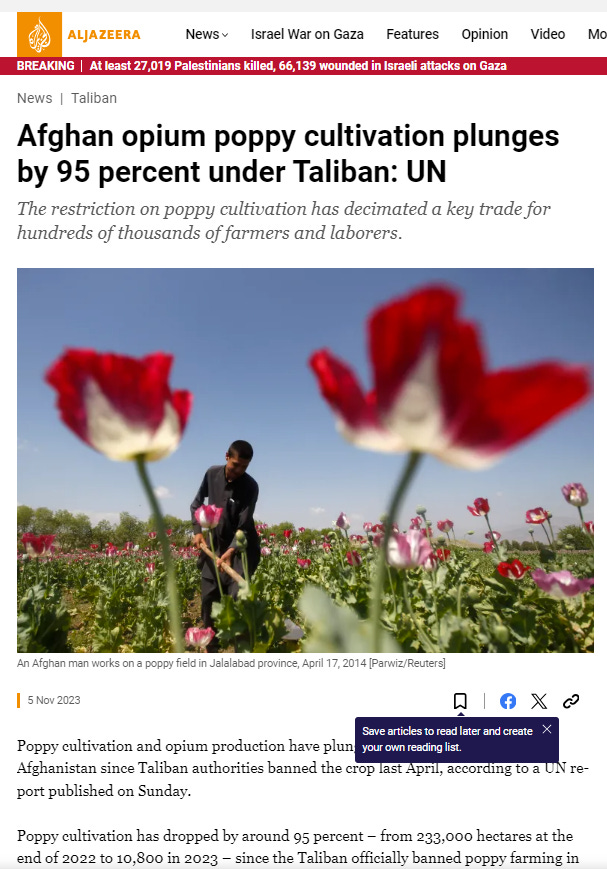
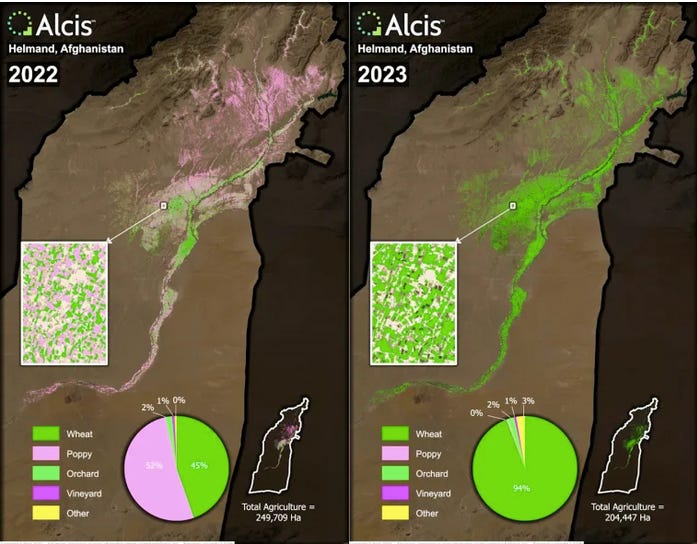
So why did we really invade Afghanistan in the wake of 9/11? Could it have been those billions of dollars in heroin profits flowing into a corrupt banking industry? Or was it something else still?. . .
9/11: Afghanistan — The Gas Pipeline Project
In the late 90’s Afghanistan found itself caught up in the middle of a massive geostrategic pinch that developed when countries to the north became rich from newnatural gas discoveries, whereas countries to the south were starved for natural gas.
NewsMax summarized the opportunity that the Taliban turned down, to its ultimate misfortune.
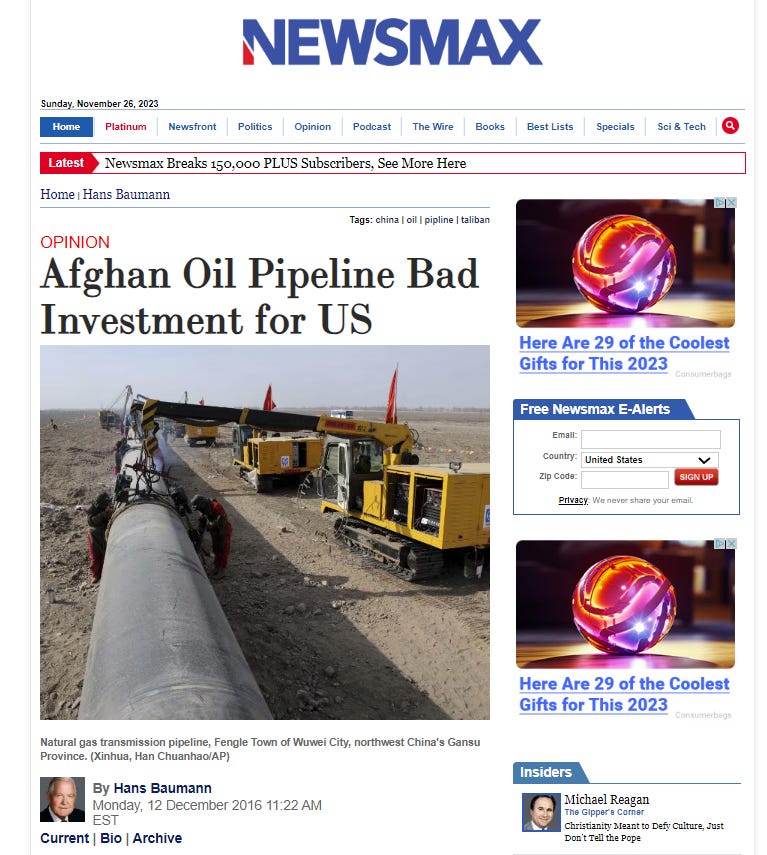
[A] U.S. company, Unocal, (since acquired by Texaco) along with several partners, including an Argentine and a Saudi oil company, signed agreements with Turkmenistan to build gas and oil pipelines in 1995.
In 1996, this agreement got further extended to include building a 36-inch natural gas pipeline from Turkmenistan to Pakistan, via Afghanistan. This line was to be extended later to India to serve a huge market with hundreds of millions of energy-starved people.
This required an agreement with the Taliban, the then effective rulers of Afghanistan. Unocal invited a Taliban delegation to their corporate head quarters in California. This resulted in an agreement signed in January, 1998to allow the pipeline to pass through their country.
In March, 1998 however, Unocal announced a delay in the pipeline project due to an ongoing civil war in Afghanistan. This tempted the Taliban — on April 30, 1999 — to conclude their own deal with Pakistan and Turkmenistan, thus excluding the U.S.
This led the U.S. government to retaliate, placing sanctions on Afghanistan.
In a final meeting with the Taliban, a U.S. delegation delivered an ultimatum…[E]ither you accept our offer of a carpet of gold, or we bury you under a carpet of bombs.” [Emphasis added.]
Following the “attacks” of 9/11/01, the US had threatened the Taliban with war if they did not turn over Osama bin Laden. The Taliban offered to do that only if given evidence of his guilt.

The late Michael Ruppert discusses this threat on page 108 of his treatise Crossing the Rubicon:
And yet it was at this time that the American representatives delivered a reported ultimatum to the Taliban to surrender bin Laden, stabilize, and negotiate, or the choices would be between a carpet of gold and a carpet of bombs.[18] This ultimatum, widely reported in the European press, evoked a number of equivocal explanations from meeting participants. Pakistani Ambassador Niaz Naik, who attended the fateful meetings, agreed that the statement was made but denied that pipelines were the subject of the negotiations. This seems unlikely, because one is compelled to ask where the “gold” for the Taliban was going to come from if not from the pipelines. [Emphasis added.]
Apparently the Taliban chose the “carpet of bombs” offered to them in Germany by US diplomat Richard Armitage, because that is exactly what the Taliban was hit with in October shortly after the 9/11/01 “attacks.”
So why did we really invade Afghanistan? Why did we keep Osama bin Laden alive and on the run for a decade following 9/11? Indeed, Osama was the perfect boogeyman, keeping the $6.5 Trillion Global War on Terror alive. But there was a better boogeyman — Saddam Hussein, the leader of Iraq, mortal enemy of Israel — right on the other side of their other mortal enemy Iran. Iran would be almost surrounded by such a new regional US dominance.
But the invasion of Iraq would also require a pretext. Surely Saddam Hussein could be fingered for the attack on the World Trade Center! Afterall, he had provable ties to Osama bin Laden — because they were so very well acquainted. (Not). And surely he had weapons of mass destruction (Not!) OK, well, Sadam did have 140 billion barrels of oil reserves.
9/11: Iraq — How Did Our Oil Get Under Their Sand?
Everyone seems to realize, in the wake of the US invasion of Iraq, that Saddam Hussein possessed neither weapons of mass destruction nor ties to Osama Bin Ladin. So what was the driving force to invade Iraq?
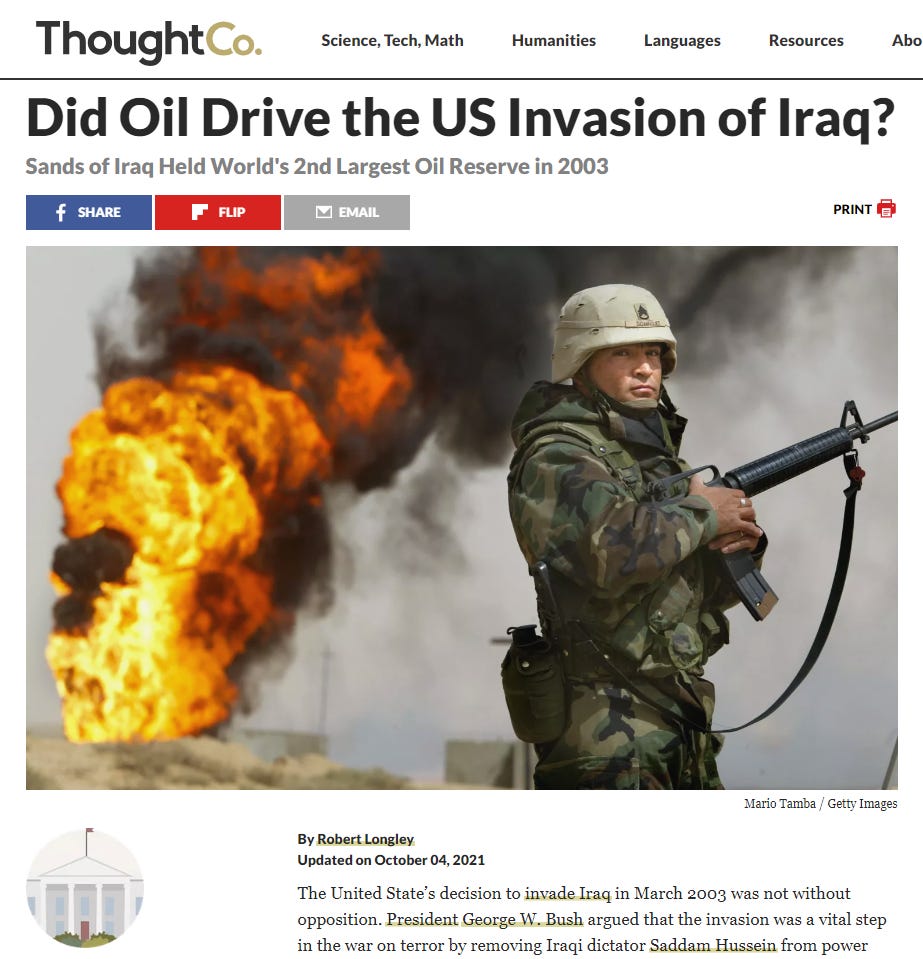
[In] a February 2002 address, then-Secretary of Defense Donald Rumsfeld called that oily assertion “utter nonsense.”
“We don’t take our forces and go around the world and try to take other people’s real-estate or other people’s resources, their oil. That’s just not what the United States does,” Rumsfeld said. “We never have, and we never will. That’s not how democracies behave.”
Nonsense aside, the sands of Iraq in 2003 held oil… lots of it.
According to data from US Energy Information Administration (EIA) at the time, “Iraq holds more than 112 billion barrels of oil — the world’s second-largest proven reserves. Iraq also contains 110 trillion cubic feet of natural gas, and is a focal point for regional and international security issues.”
In 2014 the EIA reported that Iraq held the fifth-largest proven crude oil reserves in the world, and was the second-largest crude oil producer in OPEC. [Emphasis added.]
Even the Deep State mouthpiece CNN acknowledged the obvious — more than ten years ago:
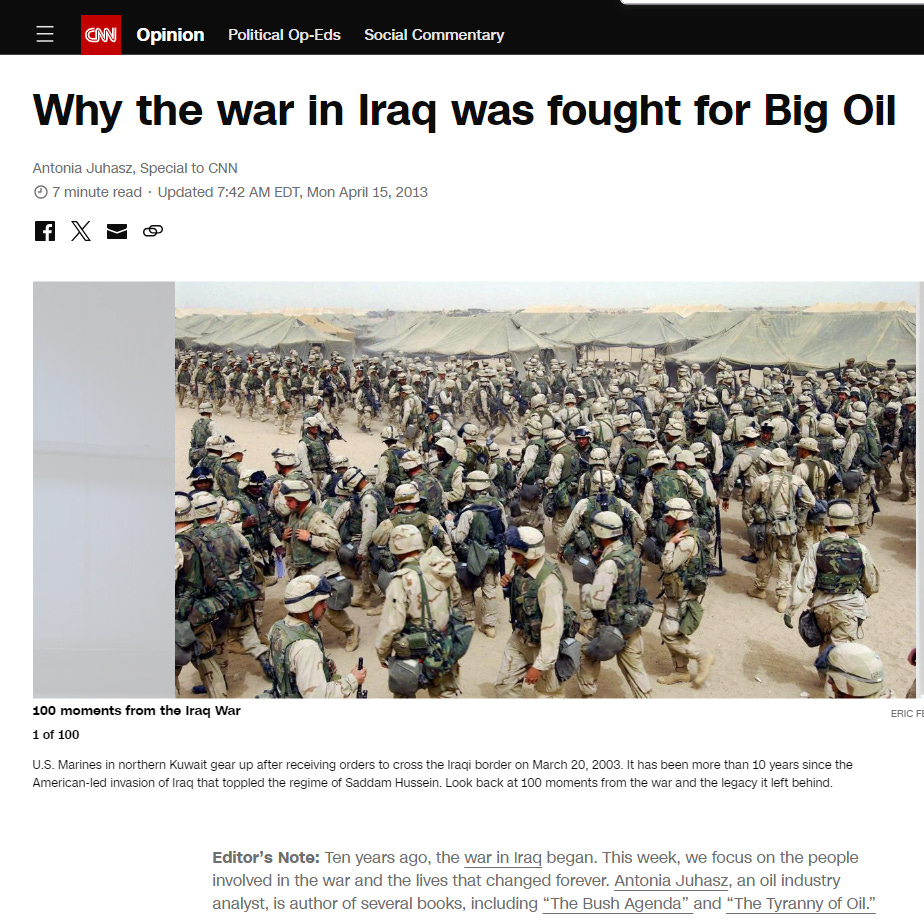
Yes, the Iraq War was a war for oil, and it was a war with winners: Big Oil.
It has been 10 years since Operation Iraqi Freedom’s bombs first landed in Baghdad. And while most of the U.S.-led coalition forces have long since gone, Western oil companies are only getting started.
Before the 2003 invasion, Iraq’s domestic oil industry was fully nationalized and closed to Western oil companies. A decade of war later, it is largely privatized and utterly dominated by foreign firms.
From ExxonMobil and Chevron to BP and Shell, the West’s largest oil companies have set up shop in Iraq. So have a slew of American oil service companies, including Halliburton, the Texas-based firm Dick Cheney ran before becoming George W. Bush’s running mate in 2000.
The war is the one and only reason for this long sought and newly acquired access. [Emphasis added.]
Gaza: An Early Vision: “The Greater Israel”
Some may be surprised to learn that Israeli history didn’t start on 10/7, just like US history didn’t start on 9/11. In the final article of this series we will go back more than 250 years to look at much deeper roots, including the roots of the cabal that has come to infiltrate Western banking, governments, and religions. In that upcoming article we will familiarize ourselves with the British Colony of Palestine and the Zionists’ goals for the artificial creation of the nation of Israel.
Primarily Muslims and Christians, and a much smaller number of Jews lived in Palestine relatively peacefully under the rule of the Ottoman Empire from the 14th century to the early 20th century.
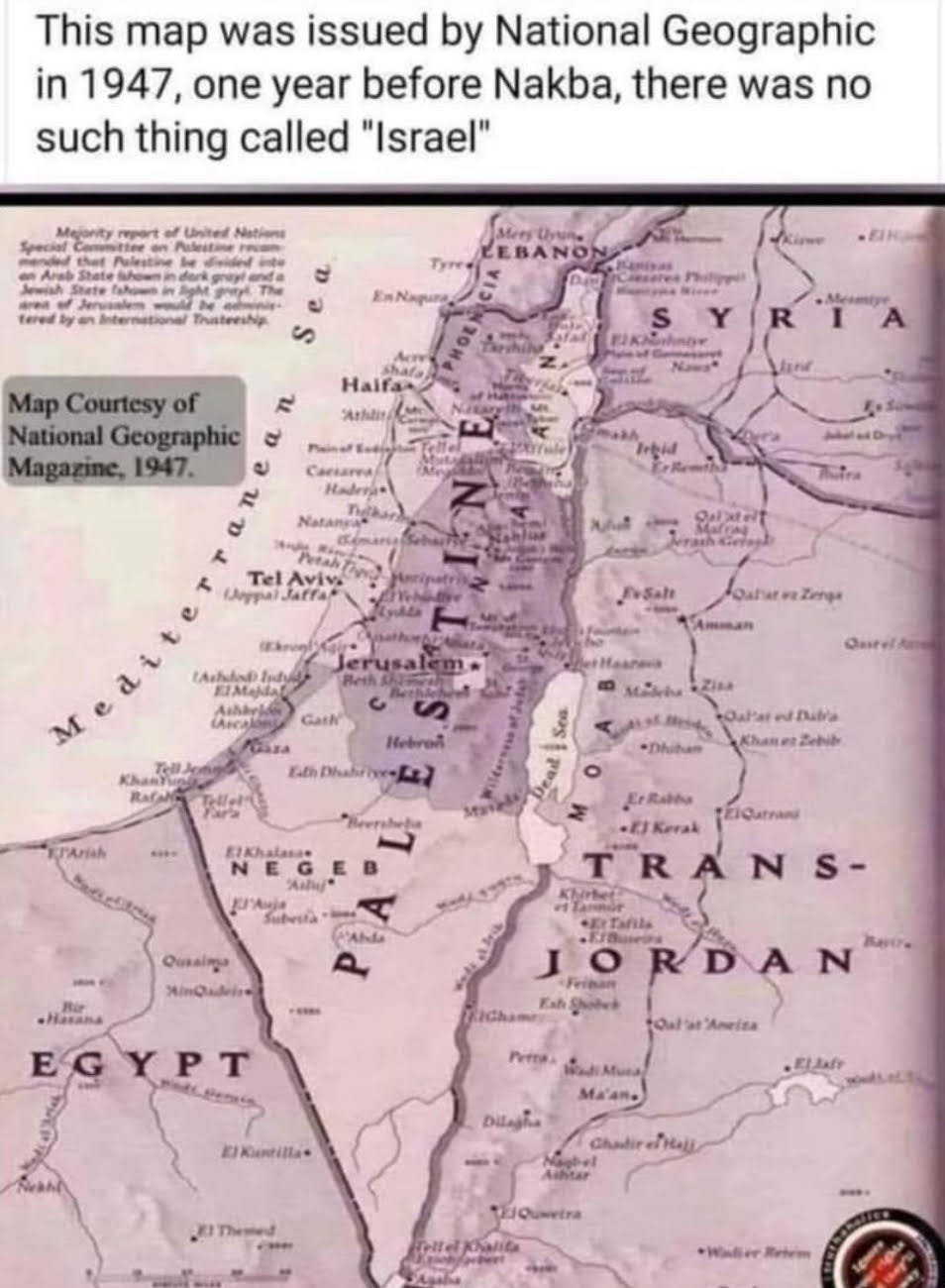
Those three religious groups in the area eventually developed a loose affiliation as “Palestinians” beginning more than 1800 years ago, ever since the Romans had originally named the land “Palestine” during their occupation of the territory.
Following World War 1 the Ottoman Empire fell and the British became the controlling power of “The British Mandate for Palestine.” As the force of Zionism — the desire for a national homeland for the Jewish people — grew, along with tens of thousands of Jews emigrating to the area, violent conflicts between local Arabs and Jews also grew.
Jewish political activist Theodor Herzl (1860—1904) is credited as the father of modern Zionism and he influenced many Jews to emigrate to Palestine.
“We must expropriate gently the private property on the state assigned to us. We shall try to spirit the penniless population across the border by procuring employment for it in the transit countries, while denying it employment in our country.” Theodor Herzl [Emphasis added.]
The above statement from the founder of Zionism, and many similar statements by other Zionist leaders, make it readily apparent that the transfer of the Palestinian Arab population, along with an apartheid policy (yet another crime against humanity) were inherent in Zionism from its inception.
Furthermore, the territorial ambitions of the Zionists far exceeded that of Palestine alone. According to Zionism’s founder Herzl, “[T]he area of the Jewish State stretches: “From the Brook of Egypt to the Euphrates.” [Emphasis added] Rabbi Fischmann, member of the Jewish Agency for Palestine, declared in his testimony to the U.N. Special Committee of Enquiry on 9 July 1947: “The Promised Land extends from the River of Egypt up to the Euphrates, it includes parts of Syria and Lebanon.” [Emphasis added.]
The ruling Brits attempted to resist the increasing numbers of Jewish emigres to Palestine in the early 1900’s, on the basis that the result was out-of-control sectarian violence. Jews comprised only about 2% of the half-million Palestinian population at the end of the Ottoman Empire before the turn of the century, their ranks climbed to about 11% by 1917, and rose to about 30% by 1945. The British Monarchy eventually yielded to the increasing international pressure calling for a Jewish homeland and signed the Balfor Declaration in 1917.
Eventually in 1947, exhausted by the many acts of sectarian violence and terrorism against the military rule, by, but not exclusively, Jewish groups (such as the Irgun, Lehi, and Hagenah) from 1938 to 1946 (see forthcoming Part 2: “A Rich History of Historic and Recent Provocations and False Flag Operations.”), they sought in earnest to fulfill their 1917 promise made to the Zionist Congress.
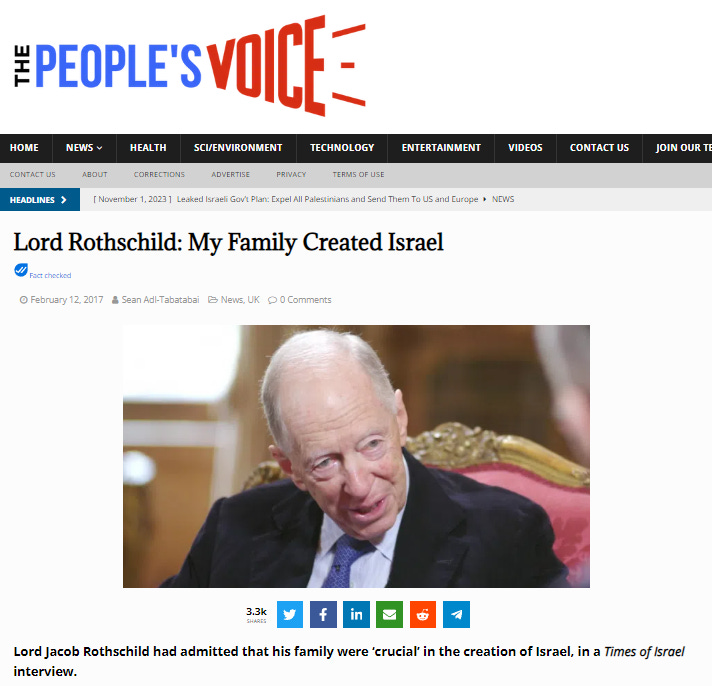
The late 80-year-old Rothschild said in an interview last year that his ancestors “helped pave the way for the creation of Israel”, forcing the British government to sign the Balfour Declaration in 1917.
The Rothschilds are commonly believed to have engineered WWI and waited until 1917 when Britain showed signs of trouble. The Zionist-oriented family then offered the British Government their assistance in funding the war and also convincing the US to formally engage in order to help Britain’s victory over Germany — in exchange for the British paving the way for a new nation of Israel in Palestine. [Emphasis added.]
Thus the Balfour Declaration was an official letter from the British Government Foreign Secretary James Balfour to Baron Rothschild:
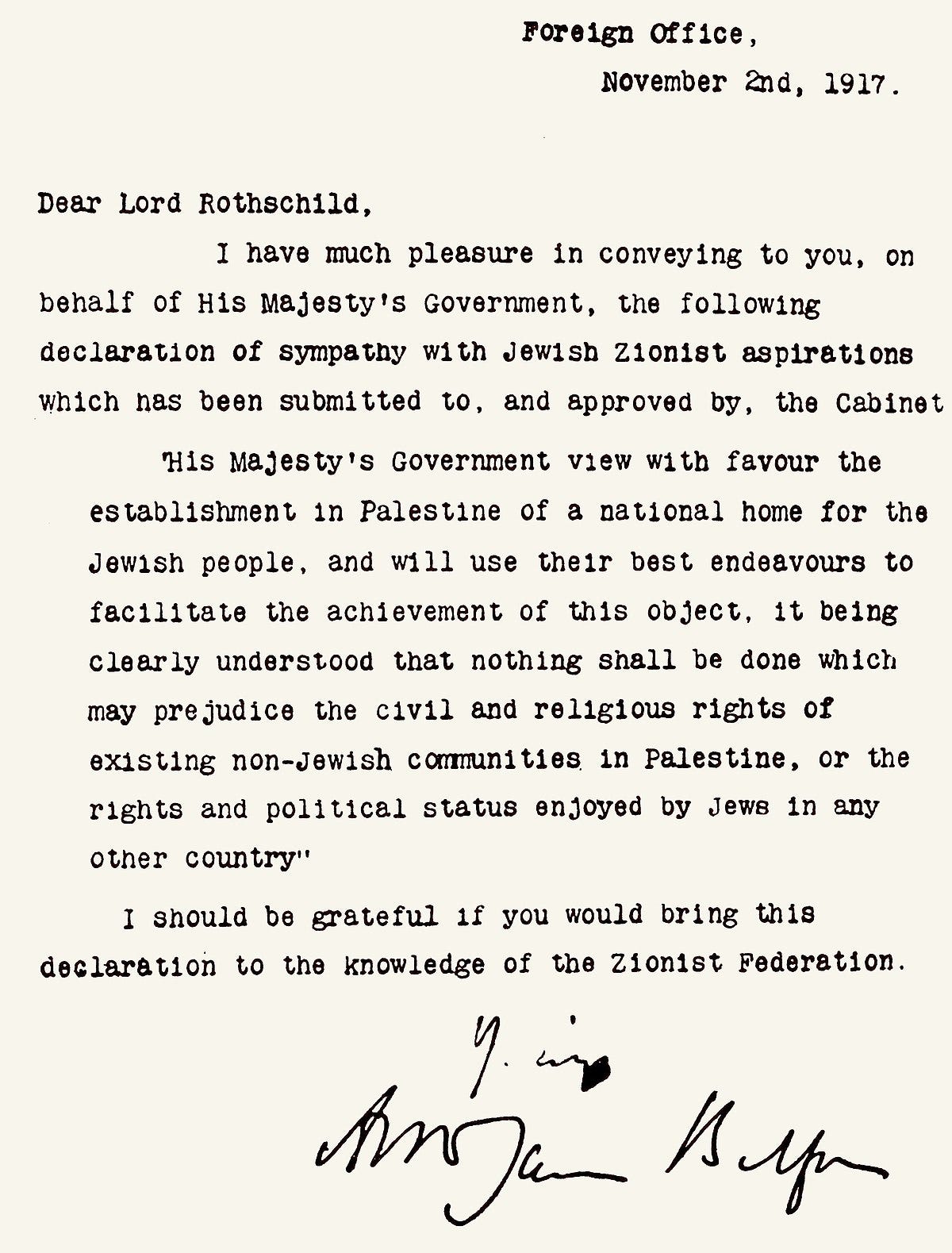
Importantly, it stresses that, “nothing shall be done which may prejudice the civil and religious rights of existing non-Jewish communities in Palestine. . .” [Emphasis added.]
The following interview of Lord Jacob Rothschild (formerly “Bauer”) was conducted by Daniel Taub, former Israeli ambassador, celebrating the 100-year anniversary of the document. (Taub interviewed Rothschild at Waddesdon Manor in Buckinghamshire, a manor bequeathed to the nation by the Rothschild family in 1957, where the Balfour Declaration is housed.)
The Balfour Declaration of 1917 had an immediate and harsh reaction from the Palestinian Muslim community. One representative declared, “[T]his will have as a result, the replacement of the Arabs by the Jews. . . It is opposed by All Arabs in the [Middle] East.” [Emphasis added.]
Al Jazeera spoke with Avi Shlaim, a historian and professor emeritus of international relations at the University of Oxford, about the motivation behind the fateful document and its ongoing legacy:
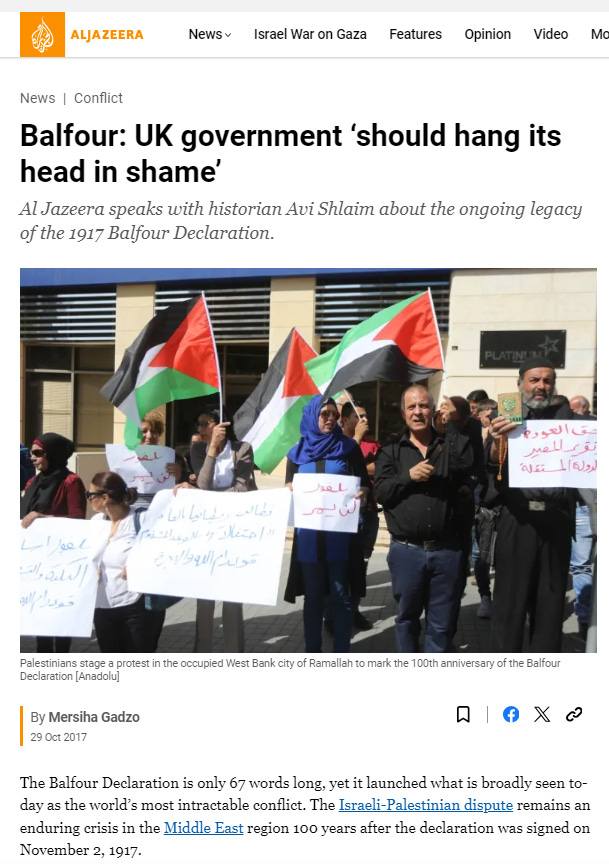
Shlaim: This shows the absurdity of the Balfour Declaration in denying national rights to the 90 percent majority and granting it to the 10 percent minority. Arthur Balfour knew full well that his declaration contradicted the principle of national self-determination. In short, the Balfour Declaration was a classic colonial document, which completely disregarded the rights and aspirations of the people of the country.
Britain had no moral or legal right to promise Palestine to the Jews as a national home. The concept “national home” does not exist under international law, and one Jewish writer Arthur Koestler, summed it up by saying: One nation, Britain, promised the country of another people, the Palestinians, to a third people, the Jews. [Emphasis added.]
See this.
The British approved the 1947 UN Plan to divide British Palestine into two separate states — one for Jews and one for Arabs. This started the 1947—1948 Arab Israeli War in which Israel nearly doubled the amount of territory originally granted by the UN, and which saw tens of thousands of Palestinians forced from the country.
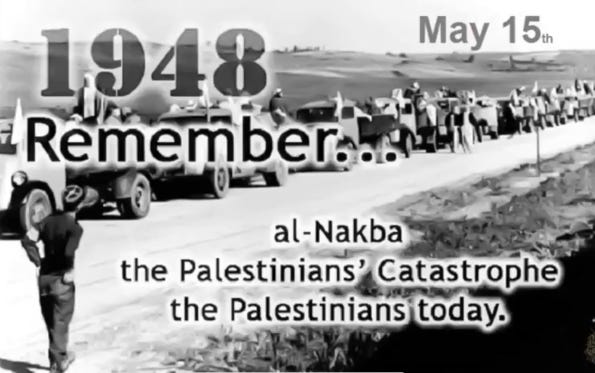
Note that about half of the historic nation of Palestine was carved up and given to Israel, even though its population was 90% Palestinians. The 1947 UN fulfillment of the original English Monarchy Balfour Declaration fulfilled the 1917 promise (for a Nation for the Jewish People) to Lord Rothschild and to the 1899-founded Zionist Federation.
This was in return for his promise to pull some heavy strings in order to bring America into England’s war (WW1) which at the time they were losing to Germany.
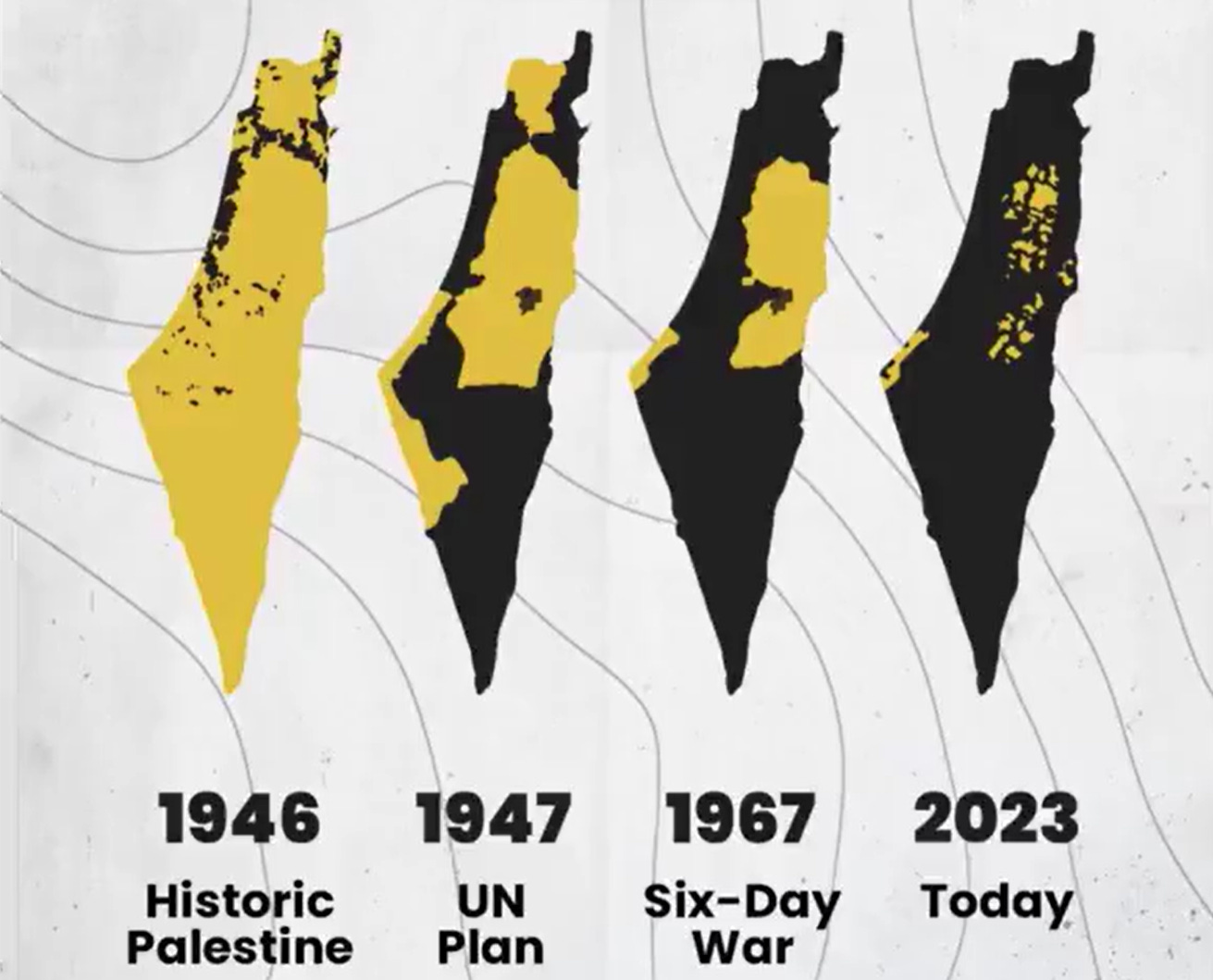
As you can see by territory colored in black, today, Israel is in control of nearly all of Palestine — nearly doubling the area granted to it under the original UN Plan.

Accordingly, In the subsequent 1967 “Six-Day War”, Israel seized not only the remaining Palestinian territory but a significant portion of Syria to the north and of Egypt to the south.
This left Israel as an occupier of those territories and their people. But since then three-quarters of a million Israelis have illegally moved into and taken over significant portions of the occupied West Bank and Gaza territories (initially granted to Palestinian Arabs as a Palestinian State by the UN). The Israeli settlers were subsidized by the Israeli government and protected by their military, forcing hundreds of thousands of Palestinians out of their ancestral homes.
Interestingly, in 2005, Israel removed all of its settlers from the Gaza Strip. Senior advisor to Ariel Sharon, Dov Weisglass, noted, “[T]he significance of the [Gaza] disengagement plan is the freezing of the peace process. You prevent the establishment of the Palestinian State. . .” [Emphasis added]
Had the Israelis already begun their negotiations with those who became Hamas — knowing that within a year Hamas, founded and funded by Israeli and US intelligence (see Part 3 of this series), would win the 2006 Gaza Strip election and become the problem that would provide Israel the enemy it needed?
This 10-minute, fast-paced, graphically-rich, simplified summary of the history of the conflict by Johnny Harris seems to provide an objective assessment for those less familiar with the important facts and historical context of the Israeli/Palestinian conflict during the last century:
A deeper dive into the vast set of issues from If Americans Knew, written by Jews sensitive to the indigenous population of Palestine, highlights the absurdity of the Zionist land claim to Palestine. What don’t you know yet?
To be continued…
*
Note to readers: Please click the share button above. Follow us on Instagram and Twitter and subscribe to our Telegram Channel. Feel free to repost and share widely Global Research articles.
This article was originally published on the author’s website, RichardGage911.
Richard Gage, AIA is a 30-year San Francisco Bay Area architect and member of the American Institute of Architects. He is the founder and former CEO of Architects & Engineers for 9/11 Truth. He now leads the charge for a new WTC investigation.
Featured image source


